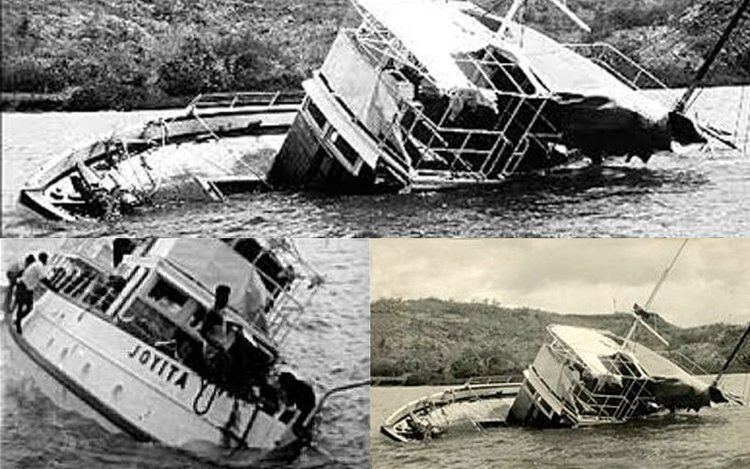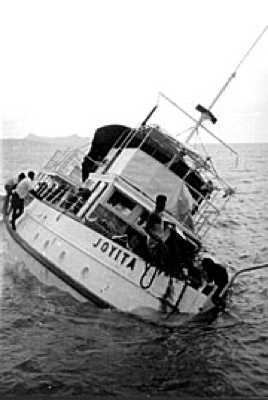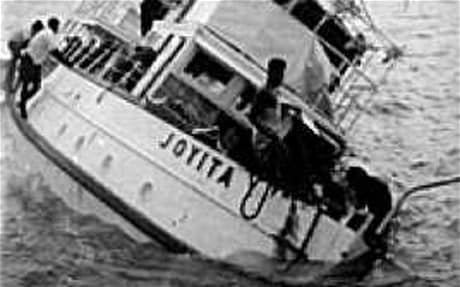Name Joyita Builder Wilmington Boat Works Length 21 m | Name YP-108 | |
 | ||
Fate Acquired by the United States Navy, October 1941 | ||
MV Joyita was a merchant vessel from which 25 passengers and crew mysteriously disappeared in the South Pacific in 1955. It was found adrift in the South Pacific with no one aboard. The ship was in very poor condition, with corroded pipes and a radio which, while functional, had a range of only about 2 miles (3.2 km), because of faulty wiring. However, the extreme buoyancy of the ship made sinking nearly impossible. Investigators were puzzled as to why the crew had not remained on board and waited for help.
Contents
- Construction
- US Navy service in World War II
- Private purchase
- Disappearance
- Maritime inquiry
- Hypotheses
- Captain injured hypothesis
- Japanese involvement and other hypotheses
- Insurance fraud hypothesis
- Mutiny hypothesis
- Joyita after 1955
- Crew and passengers
- References

Construction

The 69-foot (21.0 m) wooden ship was built in 1931 as a luxury yacht by the Wilmington Boat Works in Los Angeles for movie director Roland West, who named the ship for his wife, actress Jewel Carmenille — joyita in Spanish meaning "little jewel". In 1936 the ship was sold and registered to Milton E. Beacon. During this period, she made numerous trips south to Mexico and to the 1939–1940 Golden Gate International Exposition in San Francisco. During part of this time, Chester Mills was the skipper of the vessel.

The ship's hull was constructed of 2-inch (51 mm)-thick cedar on oak frames. She was 69 feet 0 inches (21.0 m) long, with beam of 17 feet 0 inches (5.2 m) and a draft of 7 feet 6 inches (2.3 m); her net tonnage was 47 tons and her gross tonnage approximately 70 tons. She had tanks for 2,500 U.S. gallons (9,500 L) of water and 3,000 U.S. gallons (11,400 L) of diesel fuel.
U.S. Navy service in World War II
In October 1941, just before the attack on Pearl Harbor, Joyita was acquired by the United States Navy and taken to Pearl Harbor, Hawaii, where she was outfitted as Yard patrol boat YP-108. The Navy used her to patrol the big island of Hawaii until the end of World War II. In 1943 she ran aground and was heavily damaged, but the Navy was in need of ships so she was repaired. At this point, new pipework was made from galvanized iron instead of copper or brass. In 1946, the ship was surplus to Navy requirements and most of its equipment was removed.
Private purchase
In 1948 Joyita was sold to the firm of Louis Brothers. At this point, cork lining was added to the ship's hull along with refrigeration equipment. The ship had two Gray Marine diesel engines providing 225 horsepower (168 kW), and two extra diesel engines for generators. In 1950 William Tavares became the owner; however, he had little use for the vessel, and sold it in 1952 to Dr Katharine Luomala, a professor at the University of Hawaii. She chartered the boat to her friend, Captain Thomas H. "Dusty" Miller, a British-born sailor living in Samoa. Miller used the ship as a trading and fishing charter boat.
Disappearance
About 5:00 AM on October 3, 1955, Joyita left Samoa's Apia harbor bound for the Tokelau Islands, about 270 miles (430 km) away. The boat had been scheduled to leave on the noon tide the previous day but her departure was delayed because her port engine clutch failed. Joyita eventually left Samoa on one engine. She was carrying sixteen crew members and nine passengers, including a government official, a doctor (Alfred "Andy" Denis Parsons, a World War II surgeon on his way to perform an amputation), a copra buyer, and two children. Her cargo consisted of medical supplies, timber, 80 empty 45 gallon (200 l) oil drums and various foodstuffs.
The voyage was expected to take between 41 and 48 hours. She was scheduled to return with a cargo of copra. Joyita was scheduled to arrive in the Tokelau Islands on October 5. On October 6 a message from Fakaofo port reported that the ship was overdue. No ship or land-based operator reported receiving a distress signal from the crew. A search and rescue mission was launched and, from 6 to 12 October, Sunderlands of the Royal New Zealand Air Force covered a probability area of nearly 100,000 square miles (260,000 km2) of ocean during the search. But no sign of Joyita nor any of her passengers or crew was found.
Five weeks later, on November 10, Gerald Douglas, captain of the merchant ship Tuvalu, en route from Suva to Funafuti, sighted Joyita more than 600 miles (970 km) west from her scheduled route, drifting north of Vanua Levu. The ship was partially submerged and listing heavily (her port deck rail was awash) and there was no trace of any of the passengers or crew; four tons of cargo were also missing. The recovery party noted that the radio was discovered tuned to 2182 kHz, the international marine radiotelephone distress channel.
There was still fuel in Joyita's tanks; from the amount used, it was calculated she made some 243 miles (391 km) before the vessel was abandoned, probably within 50 miles (80 km) of Tokelau. The leak had probably started after 9 p.m. on the second night of the voyage, with nine hours of darkness ahead.
Although Joyita was found with her bilges and lower decks flooded, her hull was sound. When she was moored back in harbour at Suva, investigators heard the sound of water entering the vessel. It was found that a pipe in the raw-water circuit of the engine's cooling system had failed due to galvanic corrosion, allowing water into the bilges. The first the crew would have known about the leak was when the water rose above the engine room floorboards, by which time it would have been nearly impossible to locate the leak. Also, the bilge pumps were not fitted with strainers, and had become clogged with debris, meaning that it would have been very difficult to pump the water out.
Maritime inquiry
A subsequent inquiry found that the vessel was in a poor state of repair, but determined that the fate of the passengers and crew was "inexplicable on the evidence submitted at the inquiry." An especially inexplicable point was that the three liferafts Joyita carried were missing, but it would not make sense for the crew and passengers to voluntarily abandon the vessel. Fitted out for carrying refrigerated cargo, Joyita had 640 cubic feet (18 m3) of cork lining her holds, making her virtually unsinkable. In addition, further buoyancy was provided by a cargo of empty fuel drums.
The inquiry was only able to establish the reasons for the vessel becoming flooded. It found that the vessel would have begun to flood due to the fractured cooling pipe. The bilge pumps were unserviceable due to becoming blocked. Joyita lacked watertight bulkheads or subdivisions in the bilges. The water would have gradually flooded the lower decks. As the boat began to sink lower into the water, the one remaining engine would not have been able to maintain enough speed to steer. Joyita then fell beam-on to a heavy swell and took on the heavy list it was found with. While flooded to an extent which would sink a conventional vessel, Joyita stayed afloat due to her cork-lined hull and cargo of fuel drums.
The inquiry also placed much of the responsibility for the events on Miller. They found him reckless for setting out on an ocean-going voyage with only one engine and numerous minor faults, and negligent for failing to provide a working radio or properly equipped lifeboat. He was also in breach of maritime law, since he had allowed Joyita's license to carry fare-paying passengers to lapse.
The inquiry made no mention of the used medical equipment found on board.
Hypotheses
Joyita is sometimes referred to as the "Mary Celeste of the South Pacific" and has been the subject of several books and documentaries offering explanations that range from rational and conventional to supernatural and paranormal. Numerous hypotheses for the disappearance of Joyita's crew and passengers have been advanced. Many were circulated at the time of the event, and several others have been put forward since. Given the fact that the hull of Joyita was sound and her design made her almost unsinkable, a main concern of investigators was determining why the passengers and crew did not stay on board if the events were simply triggered by the flooding in the engine room.
Captain injured hypothesis
Captain Miller was well aware of the vessel's ability to stay afloat, leading some to speculate that Miller had died or become incapacitated for some reason (someone on board was injured—hence the bloodstained bandages). Without him to reassure the other people on board, they may have panicked when Joyita began to flood and taken to the liferafts. However, this in itself would not account for the missing cargo and equipment, unless the vessel had been found abandoned and had her cargo removed.
A friend of Miller's, Captain S. B. Brown, was convinced that Miller would never have left Joyita alive, given his knowledge of her construction. He was aware of tension between Miller and his American first mate, Chuck Simpson. Brown felt that Miller and Simpson's dislike of each other came to blows and both men fell overboard or were severely injured in a struggle. This left the vessel without an experienced seaman and would explain why those remaining on board would panic when the ship began to flood.
Japanese involvement and other hypotheses
The Fiji Times and Herald quoted at the time from an "impeccable source" to the effect that Joyita had passed through a fleet of Japanese fishing boats during its trip and "had observed something the Japanese did not want them to see."
The Daily Telegraph hypothesized that some still-active Japanese forces from World War II were to blame for the disappearances, operating from an isolated island base. There was still strong anti-Japanese feeling in parts of the Pacific, and in Fiji there was specific resentment of Japan being allowed to operate fishing fleets in local waters. Such theories suddenly gained credence when men clearing Joyita found knives stamped 'Made in Japan'. However, tests on the knives proved negative and it turned out the knives were old and broken- quite possibly left on board from when Joyita was used for fishing in the late 1940s.
Also there was a proposition that "the vessel's occupants were kidnapped by a Soviet submarine, with the world at the time in the midst of the growing Cold War."
Others hypothesize that modern sea pirates attacked the vessel, killed the 25 passengers and crew (and cast their bodies into the ocean), and stole the missing four tons of cargo.
Insurance fraud hypothesis
It was also revealed that Miller had amassed large debts after a series of unsuccessful fishing trips on Joyita. However, it would have been difficult to see the events surrounding Joyita as insurance fraud, given that no seacocks were found open and the ship would be almost impossible to scuttle. Also, Miller was relying on Joyita being chartered for regular runs between Samoa and Tokelau—these government charters would have quickly cleared his debts.
Mutiny hypothesis
A subsequent owner of Joyita, author Robin Maugham, spent many years investigating the vessel's past, and published his findings as The Joyita Mystery in 1962. Maugham agreed that events were started by the flooding from the broken cooling pipe and the failure of the pumps. The mattresses found covering the starboard engine were used either in an attempt to stem the leak or to protect the electrical switchboard from spray kicked up by the engine's flywheel as the water level rose. At the same time, Joyita encountered increasingly heavy swells and squally weather.
Miller, knowing Joyita to be unsinkable and desperate to reach his destination to clear his debt, pressed on. However, Chuck Simpson, and possibly other crew members, demanded that he turn back. This effectively led to mutiny and Miller and the crew struggled, during which Miller sustained a serious injury. By now the ship was entering heavier weather, with winds around 40 miles per hour (64 km/h), and with one engine and a flooded bilge, was beginning to labor. The flooding in the engine room would have eventually caused the starboard engine to fail, also cutting all the vessel's electrical power. Chuck Simpson was now in control and made the decision to abandon ship, taking the navigational equipment, logbook and supplies, as well as the injured Miller, with them.
It still seems unlikely that Chuck Simpson would choose to abandon a flooded but floating ship to take to small open rafts in the Pacific Ocean. Maugham proposed that they sighted a nearby island or reef and tried to reach it, but in the strong winds and seas the rafts were carried out to sea, leaving Joyita drifting and empty. The damage to the lightly built superstructure was caused by wave damage while the vessel was drifting in heavy seas.
Joyita after 1955
In July 1956, Joyita was auctioned off by her owners for £2,425 to a Fiji Islander, David Simpson. He refitted and overhauled her and she went to sea again that year. However, she was surrounded by legal disputes over the transfer of her registry from the United States to Britain without permission. In January 1957 she ran aground while carrying 13 passengers in the Koro Sea. She was repaired and in October 1958 began a regular trade between Levuka and Suva.
She again ran aground on a reef in November, 1959 at Vatuvalu near Levuka. She floated off the reef assisted by high tide, but while heading for port began to take in water through a split seam. The pumps were started, but it became clear that the valves for the pump had been installed the wrong way, meaning that water was pumped into the hull, not out. Now with a reputation as an 'unlucky ship' and with a damaged hull, she was abandoned by her owners and beached. She was stripped of useful equipment and was practically a hulk when she was bought by Robin Maugham, who wrote the book The Joyita Mystery (1962). He sold the hulk in 1966 to Major J. Casling-Cottle who ran a tourist and publicity bureau at Levuka. He planned to turn it into a museum and tearoom, but the plan never saw daylight. The hulk disappeared piece by piece and the process of disintegration appears to have been complete by the late 1970s.
On March 14, 1975 The Western Samoa Post Office released a set of five stamps dealing with the mystery of Joyita.
In 2009 a walkway was named after Dr. Alfred Denis Parsons near his former Torbay home in Auckland, New Zealand.
In 2012 two memory stones in honor of the event were erected in Apia, Samoa and in Fakaofo Village, Tokelau.
Crew and passengers
As of 2012, all aboard were still declared as "missing".
Passengers: (9)
- PEARLESS Roger Derrick (Pete), district officer (30), New Zealand
- PARSONS Alfred Dennis (Andy), doctor, Apia hospital (41), Ireland
- HODGKINGSON Herbert T. (Bert), dispenser, Apia hospital (49), New Zealand
- PEREIRA Joseph Hipili, radio operator (22), Tokelau (Fakaofo)
- TEOFILO Tomoniko (30), Tokelau (Fakaofo)
- LAPANA Takama, dispenser, Fakaofo hospital (51)
- LAPANA Tokelau (Fakaofo) Tekai, wife of Tala (40)
- TALAMA Founuku Uluola, their adopted son (11)
- FAIVA Liua Noama Rosaiti, their adopted daughter (3)
Note:
